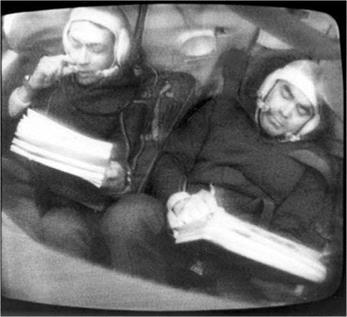SOYUZ 9
|
Int. Designation |
1970-041A |
|
Launched |
1 June 1970 |
|
Launch Site |
Pad 1, Site 5, Baikonur Cosmodrome, Kazakhstan |
|
Landed |
19 June 1970 |
|
Landing Site |
75 km west of Karaganda |
|
Launch Vehicle |
R7 (11A511); spacecraft serial number (7K-0K) #17 |
|
Duration |
17 days 16 hrs 58 min 55 sec |
|
Callsign |
Sokol (Falcon) |
|
Objective |
Extended-duration Earth orbital mission (18 days) |
Flight Crew
NIKOLAYEV, Andrian Grigoryevich, 40, Soviet Air Force, commander, 2nd mission
Previous mission: Vostok 3 (1962)
SEVASTYANOV, Vitaly Ivanovich, 34, civilian, flight engineer
Flight Log
The Soviet Union’s first long-duration biomedical space mission, Soyuz 9, blasted away from Baikonur’s Pad 1 at 00: 00 hrs local time, the first manned launch at night, and was placed into a 51.6° orbit. During one of the five in-orbit changes, it reached a maximum altitude of 259 km (161 miles). In addition to medical experiments, including a torso harness which placed a load of about 40 kg (85 lb) on the cosmonaut’s body, and other exercising equipment, the crew of Andrian Nikolayev and Vitaly Sevastyanov made several meteorological and geological observations in the relatively spacious Orbital Module. These were thwarted to a degree by a spacecraft window that had been smeared by the plume from an engine firing. These observations were compared with simultaneous observations by satellites, ships and aircraft. The crew also tested a new orientation system based on star-lock navigation, using the bright stars Canopus and Vega. After setting a new world space endurance record, Soyuz 9 came home to a “sniper accurate’’ landing in a ploughed field, 75 km (47 miles) west of Karaganda at T + 17 days 16 hours 58 minutes 50 seconds.
Doctors were keen to see whether the exercise regime and spaciousness of the Soyuz had allowed the cosmonauts to overcome what was thought to be difficult readaptation to gravity. However, as both cosmonauts were so busy they began avoiding the exercise programme and, despite a rebuke from mission control, never managed to return to the planned schedule. Both cosmonauts complained of feeling extraordinarily heavy and had to be carried out of the Soyuz 9 descent capsule. They were kept under close medical supervision for ten days, complaining of feeling twice their real weight, walking with difficulty, becoming flushed and breathing heavily.
|
Sevastyanov (left) and Nikolayev shown in the Soyuz 9 DM during their record-breaking 18-day space marathon |
They even stumbled up stairs. Nikolayev was moved to express extreme pessimism about the possibilities of long-duration space flights. He need not have worried, because the reason for their discomfort was that Soyuz 9 had been in a partial, intermittent, gravity-inducing controlled spin throughout the mission, and it was this that had caused most of their problems. Their lack of regular daily exercise was also a factor in their physical condition upon return. However, this challenging and difficult mission was a wholly successful one, and an important stepping stone towards starting the space station programme the following year.
Milestones
39th manned space flight
16th Soviet manned space flight
8th Soyuz manned space flight
1st night launch of a manned space flight











